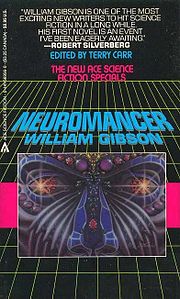Difference between revisions of "Transhumanism"
| Line 11: | Line 11: | ||
==Popular Culture References== | ==Popular Culture References== | ||
| + | [[File:neuromancer.jpg|200px|thumb|left|The original cover art for William Gibson's 1984 novel, Neuromancer.]] | ||
Transhumanism is a common theme used in science fiction media. The idea of augmenting and modifying the human body is something that has been taken to the extreme in comic books, video games, novels, movies, and even music. Among the most accepting communities has been the cyberpunk genre. This genre consists of all forms of media pertaining to the digital/virtual culture but with its true momentum beginning with William Gibson's 1984 novel Neuromancer and Bruce Sterling's 1985 novel Schismatrix. Both of these novels revolve around the idea of modifying the human body and have paved the way for many more popular culture references. | Transhumanism is a common theme used in science fiction media. The idea of augmenting and modifying the human body is something that has been taken to the extreme in comic books, video games, novels, movies, and even music. Among the most accepting communities has been the cyberpunk genre. This genre consists of all forms of media pertaining to the digital/virtual culture but with its true momentum beginning with William Gibson's 1984 novel Neuromancer and Bruce Sterling's 1985 novel Schismatrix. Both of these novels revolve around the idea of modifying the human body and have paved the way for many more popular culture references. | ||
[[Category:Concepts]] | [[Category:Concepts]] | ||
Revision as of 00:31, 7 December 2011
Transhumanism is a social and scientific movement based on the notion of transcending the current human condition through scientific and technological enhancements. These enhancements are improvements upon the mind, body, and spirit of the human being. Such improvements may be the advancement of intellect, strength, and consciousness through emerging technologies in both the bio-medical and electrical/digital industries. The transhumanism movement is controversial among futurists due to the many ethical implications that abound from the idea of the transformation of the human body.
Background
The idea of transforming the human condition has persisted throughout a majority of mankind's history. The quests for eternal youth, immortality, infinite knowledge, etc. have all been documented in stories ranging from the Fountain of Youth to the Elixir of Life. FM-2030, a teacher at The New School in New York City, began using the term "transhuman" in the 1960's. FM-2030 (originally named Fereidoun M. Esfandiary), began categorizing people who adopted emerging technologies as "transhumans." This is when the term transhuman is believed to have been born. Modern transhumanism is associated with every day culture on various levels: reliance on personal computers, prostheses allowing the wearer to run faster or be stronger, embedded bio-microprocessors, etc.
Ethics
Transhumanism has both critics and advocates. Transhumanists have coined the terms "bioconservatives" and "bioluddites", the former being those who feel emerging technologies are a threat to humanity and nature and the latter being those who advocate such breakthroughs. Bioconservatives feel the need to preserve the natural human body where as bioluddites feel that this necessity of preservation merely stifles the progress and evolution of the human species. Some bioconservatives attribute this advancement and augmentation of the human body a form of playing God and therefore inappropriate, this is, however, contested by the bioluddites.
The economics of transhumanism is another area of major criticism and source of ethical controversy. When it becomes a choice to modify ones body, it will be such that those who have the means will have the most advanced minds, bodies, and spirits. This will effectively create an even larger and more tangible rift between those who have resources and those who do not which, in turn, will divide humans into a class-based system rooted in not only socioeconomic status, as it is presently, but also in physicality.
Popular Culture References
Transhumanism is a common theme used in science fiction media. The idea of augmenting and modifying the human body is something that has been taken to the extreme in comic books, video games, novels, movies, and even music. Among the most accepting communities has been the cyberpunk genre. This genre consists of all forms of media pertaining to the digital/virtual culture but with its true momentum beginning with William Gibson's 1984 novel Neuromancer and Bruce Sterling's 1985 novel Schismatrix. Both of these novels revolve around the idea of modifying the human body and have paved the way for many more popular culture references.

